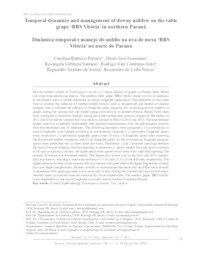Temporal dynamics and management of downy mildew on the table grape "BRS Vitória" in northern Paraná.
Temporal dynamics and management of downy mildew on the table grape "BRS Vitória" in northern Paraná.
Author(s): PEREIRA, C. B.; TESSMANN, D. J.; SANTANA, R. G.; CONTRERAS-SOTO, R. I.; SOUZA, R. T. de; NAVES, R. de L.
Summary: Downy mildew caused by Plasmopara viticola is a major disease of grapes in Paraná State, Brazil and other wine-producing regions. The seedless table grape "BRS Vitória" stands out for its tolerance to this disease and is a viable alternative to reduce fungicide applications. The objectives of this study were to analyze the influence of weather-related factors, such as temperature and rainfall on disease progress and to evaluate the efficacy of fungicide spray programs for controlling downy mildew of grapes during the summer-fall and winter-spring crop seasons in northern Paraná, Brazil. Field trials were conducted in Marialva, Paraná, during the winter-spring crop seasons (August to December) in 2013 and 2014 and the summer-fall crop seasons (January to May) in 2014 and 2015. The experimental design used was completely randomized with repeated measurements over the phenological periods, with five treatments and 10 replicates. The following treatments were compared: (1) conventional, in which fungicides were applied according to conventional standards; (2) preventive fungicide sprays every seven days; (3) preventive fungicide sprays every 14 days; (4) fungicide sprays after observing the first downy mildew symptoms; and (5) no fungicide sprays. In the conventional fungicide program, sprays were performed two or three times per week. Treatments 2 and 3 received sprayings between the start of branch budding and fruit ripening. In treatment 4, sprays started from the first occurrence of oil spot symptoms, and then, the applications were spaced every seven days until fruit ripening. The severity of disease was evaluated weekly. The disease was severe only in the 2014 and 2015 summer-fall crop seasons, reaching a maximum severity of 17.3% and 21.3% of the leaf area, respectively. The highest disease severity in the summer-fall crop seasons was associated with higher frequencies of rainy days and higher temperatures. Disease severity in conventional treatments did not differ from severity in treatments with sprayings made every seven and 14 days during the summer-fall crops in both years. Severity index on bunches were not observed for the evaluated trials. The seedless grape ?BRS Vitória? is less dependent on the use of fungicides to control downy mildew in northern Paraná. Key words: Control. Epidemiology. Plasmopara viticola. Vitis vinifera.
Publication year: 2018
Types of publication: Journal article
Unit: Embrapa Grape & Wine
Observation
Some of Embrapa's publications are published as ePub files. To read them, use or download one of the following free software options to your computer or mobile device. Android: Google Play Books; IOS: iBooks; Windows and Linux: Calibre.
Access other publications
Access the Agricultural Research Database (BDPA) to consult Embrapa's full library collection and records.
Visit Embrapa Bookstore to purchase books and other publications sold by Embrapa.

